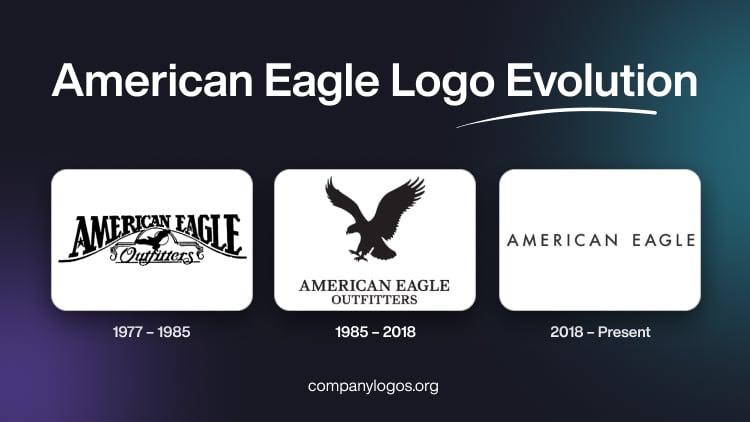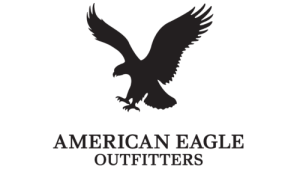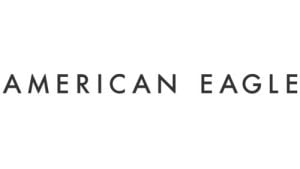
American Eagle is an apparel brand that has become synonymous with casual and youthful fashion. Founded by brothers Jerry and Mark Silverman in 1977, the product line of American Eagle Outfitters encompasses a wide range of items, such as jeans, t-shirts, sweaters, outerwear, swimwear, and various other clothing options.
The brand focuses primarily on capturing the attention of a younger demographic, specifically college and university students. Its logo encapsulates the spirit of freedom and individuality. The article explores the evolution of the American Eagle logo over the years, among other details of the company.
The Genesis of the American Eagle Logo (1977 – 1985)
The original American Eagle logo featured a straightforward but eye-catching image of an eagle in flight set against a circle representing the sun. The logo was split into two parts, with the top part highlighting the brand name, while the line below resembled a hill. The size of the brand name, written in uppercase and in an artistic serif typeface, changed based on its placement to fit the hill below.
The glyphs of the letters were heavy and bold, while the serifs had unusual shapes, especially the letters “E” and “L”. Also, beneath the eagle was mentioned “Outfitters” in a fancy script with swirls with a long horizontal line underneath.

(1985 – 2018)
In 1985, American Eagle made minor adjustments to the logo as it strengthened its market position and increased the range of products it offered. During this time, the company adopted the eagle as a representation of American youth’s carefree and adventurous spirit. Besides, the image of the swooping eagle catching its prey emphasised the dynamism and energy of the brand. The brand name “AMERICAN EAGLE OUTFITTERS” was written below the eagle motif in a smooth and thin uppercase serif typeface in two levels.

(2018 – Present)
The 2018 logo iteration saw the eagle motif removed while keeping the brand name as the logotype in uppercase. Executed in a geometric sans-serif typeface, the individual letters had adequate spacing between them. The logotype in black looks modern to convey the brand’s ability to grow.

The Elements of the American Eagle Logo
Font
The American Eagle logo features bold uppercase lettering crafted in an elegant serif font. It is characterised by distinctive contours and sharp serifs. The font closely resembles either Walbaum Pro 06pt Regular or Carot Text Medium, with minor adjustments to the characters’ outlines.
Colour
In terms of the colour palette within the American Eagle visual identity, a deep shade of blue takes centre stage. This unconventional choice for the fashion industry sets the brand apart from its competitors. It added a unique and distinguishable element to its visual presence.
The History of the American Eagle Outfitters
American Eagle Outfitters was founded in 1977 by brothers Jerry and Mark Silverman in Novi, Michigan. Initially, it was formed as part of their family business called Silverman’s Menswear. The brand started by selling leisure apparel, footwear, and accessories primarily aimed at outdoor activities like hiking and camping. Throughout the 1980s, American Eagle expanded steadily, and by 1989, it operated 137 stores across 36 states. However, despite this growth, the company faced financial difficulties in the early 1990s.
In 1980, the Schottenstein family acquired a 50% stake in the company, and by 1991, they bought out the remaining stake of the Silverman family, thereby signalling a leadership and strategic change. Under Schottenstein ownership, the brand refocused towards private-label casual clothing to target young men and women. This marked a significant turning point for growth and brand identity.
In 1994, American Eagle went public with an IPO, which provided capital to expand the store and boost brand visibility. The late 1990s and early 2000s saw the company embrace digital channels and international expansion. It opened its first overseas store in Dubai in 2010 and entered the Canadian market earlier. A key development for the brand was the launch of the Aerie sub-brand in 2006. It focused on intimate apparel and loungewear, which became a major growth driver with a focus on body positivity.
In 2007, the company also moved its headquarters to Pittsburgh, Pennsylvania. In recent years, American Eagle has enhanced its supply chain capabilities through acquisitions while continuing to grow revenue and global store presence. It has consolidated its position as a leading apparel retailer for young consumers with over 1,000 stores worldwide as of the early 2020s.
Interesting Facts About the American Eagle Outfitters
- The first store opened in 1977, initially specialising in apparel and accessories for outdoor activities like hiking and camping.
- The company experienced rapid growth and, by the late 1980s, had established dozens of stores across many U.S. states—eventually expanding internationally with over 1,180 stores.
- American Eagle’s shift in focus to its own casual wear lines in the early 1990s, under new leadership, was a turning point that spurred significant growth and set the brand’s identity.
- Going public in 1994 allowed American Eagle to expand even faster, opening many new stores around the country and building its brand.
- The Aerie sub-brand, popular for underwear and loungewear, has become increasingly successful, with the company introducing additional lines for fitness and casual wear in recent years.
- The brand’s marketing strategies have always focused on young, trend-conscious customers, and American Eagle clothing has even appeared on popular TV shows.
- Today, American Eagle is recognised for keeping up with fashion trends and maintaining a strong presence both online and in international markets, with products sold in numerous countries.
- The company continues to see substantial financial success and employs tens of thousands of people worldwide.
- The creation of American Eagle marked a major shift for the family business of the founders, who previously ran a menswear store.
- American Eagle remains a popular choice for younger shoppers and continues to play a major role in shaping fashion trends in the U.S. and beyond.
Finally
The history and evolution of the American Eagle logo tell a compelling story of a brand that has successfully navigated the ever-changing currents of the fashion industry. From its early days as a denim-focused label to its current status as a lifestyle brand promoting diversity and inclusivity, the American Eagle logo has been a visual anchor for its identity.